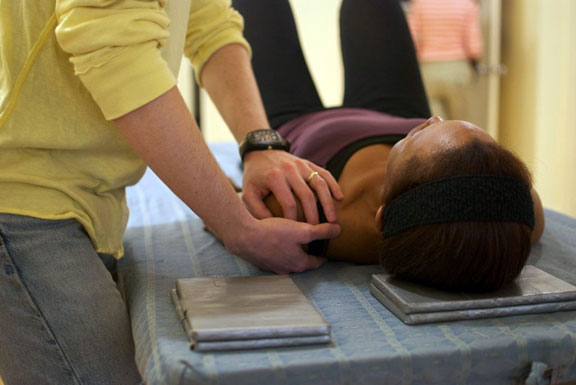by Brooke Lieb
August 28, 2014: Gail Heimberg is a long time student of the Alexander Technique and has served on the ACAT Board since 2010. After managing a computer store in the early days of microcomputers, she founded her computer consulting and training company, Techknowledge/G in 1990. She volunteers for other organizations and also serves on the Board of her
BROOKE
How did you first discover the Alexander Technique?
GAIL
I had neck pain for many years. At a seminar someone suggested I try the Alexander Technique or Feldenkrais. I eventually went to a physical therapist that used Feldenkrais and found it helped only for a short time after a session. The pain always returned.
In 1999, I’d been doing computer consulting for years and went to a new client. As I sat crouched over her computer, she said if I touch the top of your ears you could let your head go up. It did! What a rush! This was Beret Arcaya. She suggested I go for a series of lessons with a protégé of hers. I did. My neck pain disappeared, never to return.
BROOKE
What were your early lessons like?
GAIL
At first I thought I wasn’t getting it but I liked it and I think I could connect physically to the subtle changes that happen in each lesson. My teacher was lovely, clear and so patient.
BROOKE
How long have your been studying?
GAIL
I have studied continuously since 1999. I always felt that I was changing and that although I couldn’t “get there”, I was continuing to improve.
BROOKE
What kinds of shifts and/or changes have you noticed in your understanding of the work?
GAIL
As I am getting older, I delight in the fact that I am still changing, still improving. That I look and move so much more youthfully that I could have possibly otherwise.
The lessons and the technique have helped me through illness and surgery, I lost my midrange voice and Beret Arcaya and the Alexander Technique helped me to get it back.
BROOKE
How do you apply it to daily life, and/or use it in practical ways?
GAIL
Even more exciting to me than improving physically is how it’s helped emotionally. I actually figured out that negative thinking was a habit and I could stop when I was aware of it. Friends asked me once what kind of meditation practice I did. I cited using the Technique and “stopping."
Perhaps the hardest thing for me (maybe for everyone) is to remember to be aware in all activities. It’s something to keep working on!
BROOKE
What keeps you engaged in study?
GAIL
When I see a picture of F. M. Alexander or hear about other teachers who could move easily when they were elderly; I say to myself, I want that! I love the idea of always improving!
Lessons are so helpful when I’m tired, stressed or something is not quite right in my body.
BROOKE
What would you say to a newer student, to give them a preview of what happens after a long course of study?
GAIL
I love to tell people that this is fantastic and it will help them now and way into the future. It will help with what brought them to lessons but that if they keep it up, even more great things will happen.
What I don’t love is how hard it is to get someone to appreciate how fantastic this is, how much it’s helped me and how much it could help him or her.
BROOKE
How has your understanding or concept of the Alexander technique evolved over the years?
GAIL
I really think that I am always finding new ways to appreciate this work and my body. I know there were uncharted and “unexperienced” physical and emotional places that I discovered and still discovering.
BROOKE
What inspires you to serve on the ACAT Board?
GAIL
I want the world to know there is something that actually works to alleviate pain and to improve one’s experiences in life; to help spread the word.
I have also found the people who have served with me, delightful to work with and they have the same goals. I have served as “a body” at the school and was very impressed by the level of the training we offer. I learned something new each time!
Try a lesson one-on-one with
a certified Alexander Technique teacher
.

